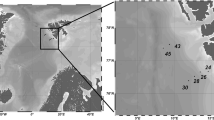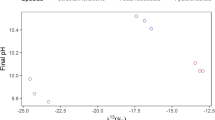Abstract
Bacterial production, respiration and metabolic diversity were measured up to 120 m depth in the Sub-Antarctic Front (SAF) and Polar Fronts I and II (PFI and PFII) of the Indian Ocean sector of the Southern Ocean during 2010 Austral Summer. Prokaryotic cell count was maximum at PFI and PFII (~109 cells L−1) and minimum at SAF (~107 cells L−1). Furthermore, integrated bacterial production was higher at PFI (1.07 mg C m−2 h−1) and PFII (0.72 mg C m−2 h−1) compared to SAF (0.61 mg C m−2 h−1). At PFII, integrated bacterial growth efficiency was higher (8.96) compared to PFI (7.42) and SAF (7.17), signifying that the net contribution of PFII to the microbial loop could be relatively pronounced. Enhanced cell numbers and production at polar fronts indicate that the dissolved organic matter could be converted to secondary biomass through the microbial loop. However, integrated bacterial respiration rate at PFII (0.83 mg C m−2 h−1) was lower than that at PFI (1.84 mg C m−2 h−1) resulting in higher growth efficiency at PFII. Metabolic flexibility at SAF was clearly brought about by utilization of carboxylic acids like D-malic acid and itaconic acid, and carbohydrates like N-acetyl D-glucosamine, D-cellobiose and D-lactose. Utilization of amino acids like glycyl L-glutamic acid and L-threonine, and an amine, phenylethylamine, was critical in determining the metabolic variability at PFI. PFII hosted microbes that utilized phenolic compounds (2-hydroxy benzoic acid and 4-hydroxy benzoic acid) and polymers (like Tween 80). Utilization of polyols over carbohydrates in polar waters indicates a niche with lesser influence of the Antarctic melt waters on the bacterioplankton metabolism.





Similar content being viewed by others
References
Ansorge IJ, Pakhomov EA, Kaehler S, Lutjeharms JRE, Durgadoo JV (2009) Physical and biological coupling in eddies in the lee of the South-West Indian Ridge. Polar Biol 33:747–759
Arrieta JM, Weinbauer MG, Lute C, Herndl GJ (2004) Response of bacterioplankton to iron fertilization in the Southern Ocean. Limnol Oceanogr 49:799–808
Arrigo KR, Thomas DN (2004) Large scale importance of sea ice biology in the Southern Ocean. Antarct Sci 16:471–486
Becquevort S, Menon P, Lancelot C (2000) Differences of the protozoan biomass and grazing during spring and summer in the Indian sector of the Southern Ocean. Polar Biol 23:309–320
Berggren M, Laudon H, Jonsson A, Jansson M (2010) Nutrient constraints on metabolism affect the temperature regulation of aquatic bacterial growth efficiency. Microb Ecol 60:894–902
Bjornsen PK, Kuparinen J (1991) Determination of bacterioplankton biomass, net production and growth efficiency in the Southern Ocean. Mar Ecol Prog Ser 71:185–194
Bonilla-Findji O, Malits A, Lefèvre D, Rochelle-Newall E, Lemée R, Weinbauer MG et al (2008) Viral effects on bacterial respiration, production and growth efficiency: consistent trends in the Southern Ocean and the Mediterranean Sea. Deep Sea Res PTII 55:790–800
Brierley AS, Thomas DN (2002) Ecology of Southern Ocean pack ice. Adv Mar Biol 43:171–276
Carlson A, Bates N, Ducklow HW, Hansell DA (1999) Estimation of bacterial respiration and growth efficiency in the Ross Sea, Antarctica. Aquat Microb Ecol 19:229–244
Carpenter JH (1965) The Chesapeake Bay Institute technique for the Winkler 23 dissolved oxygen method. Limnol Oceanogr 10:141–143
Chisholm S, Morel FMM (1991) Ocean fertilization and atmospheric carbon dioxide. Limnol Oceanogr 36: preface.
Church MJ, Hutchins DA, Ducklow HW (2000) Limitation of bacterial growth by dissolved organic matter and Iron in the Southern Ocean. Appl Environ Microbiol 66:455–466
Davis J, Benner R (2005) Seasonal trends in the abundance, composition and bioavailability of particulate and dissolved organic matter in the Chukchi/Beaufort Seas and western Canada Basin. Deep Sea Res PTII 52:3396–3410
del Giorgio PA, Cole JJ (1998) Bacterial growth efficiency in natural aquatic ecosystems. Annu Rev Ecol Syst 29:503–541
Ducklow HW, Schofield O, Vernet M, Stammerjohn S, Erickson M (2012) Multiscale control of bacterial production by phytoplankton dynamics and sea ice along the western Antarctic Peninsula: a regional and decadal investigation. J Mar Syst 98–99:26–39
Evans C, Brussaard CPD (2013) Regional variation in lytic and lysogenic viral infection in the Southern Ocean and its contribution to biogeochemical cycling. Appl Environ Microbiol. doi:10.1128/AEM.01388-12
Fenchel T (2002) Microbial behavior in a heterogeneous world. Science 296:1068–1071
Fuhrman JA, Azam A (1980) Bacterioplankton secondary production estimates for coastal waters off British Columbia, Antarctica and California. Appl Environ Microbiol 39:1085–1095
Grasshoff K (1983) Determination of nitrate. In: Grasshoff K, Ehrhardt M, Kremling K (eds) Methods of seawater analysis. Verlag Chemie, Weinheim, p 143
Hicks RE, Amann RI, Stahl DA (1992) Dual staining of natural bacterioplankton with 4’, 6-diamidino-2-phenylindole and fluorescent oligo nucleotide probes targeting kingdom-level 16S rRNA sequences. Appl Environ Microbiol 58:2158–2163
Hubberten U, Lara RJ, Kattner G (1995) Refractory organic compounds in polar waters: relationships between humic substances and amino acids in the Arctic and Antarctic. J Mar Res 53:137–149
Insam H (1997) A new set of substrates proposed for community characterization of environmental samples. In: Insam H, Rangger A (eds) Microbial communities: Functional versus structural approaches. Springer, Berlin, p 261
Jensen LM, Sand-Jensen K, St M, Hansen M (1990) Plankton community respiration along a nutrient gradient in a shallow Danish estuary. Mar Ecol Prog Ser 61:75–85
Kahler P, Bjornsen PK, Lochte K, Antia A (1997) Dissolved organic matter and its utilization by bacteria during spring in the Southern Ocean. Deep Sea Res PTII 44:341–353
Kirchman DL (1993) Leucine incorporation as a measure of biomass production by heterotrophic bacteria. In: Kemp PF, Sherr BF, Sherr EB, Cole JJ (eds) Handbook of methods in aquatic microbial ecology. Lewis Publishers, Boca Raton, pp 509–512
Kirchman DL (2000) Uptake and regeneration of inorganic nutrients by marine heterotrophic bacteria. In: Kirchman DL (ed) Microbial ecology of the oceans. Wiley-Liss, US, p 261
Kirchman DL, Moran XAG, Ducklow H (2009) Microbial growth in the polar oceans - role of temperature and potential impact of climate change. Nat Rev Microbiol 7:451–459
Knap AH, Michaels AE, Close AR, Ducklow HW, Dickson AG (1996) Protocols for the joint global ocean flux study (JGOFS) core measurements, vol 19. UNESCO, Bergen, p 210
Knox GA (1994) The biology of the Southern Ocean. Cambridge University Press, Cambridge, p 444
Kogure K, Fukami K, Simidu U, Taga N (1986) Abundance and production of bacterioplankton in the Antarctic. Natl Inst Polar Res 40:414–422, Spec Issue
Krembs C, Eicken H, Junge K, Deming JW (2002) High concentrations of exopolymeric substances in Arctic winter sea ice: implications for the polar ocean carbon cycle and cryoprotection of diatoms. Deep Sea Res PTI 49:2163–2181
Laubscher RK, Perisinotto R, McQuaid CD (1993) Phytoplankton production and biomass at frontal zones in the Atlantic sector of the Southern Ocean. Polar Biol 13:471–481
Lemée R, Rochelle-Newall E, Van Wambeke F, Pizay M-D, Rinaldi P, Gattuso J-P (2002) Seasonal variation of bacterial production, respiration and growth efficiency in the open NW Mediterranean Sea. Aquat Microb Ecol 29:227–237
Lutjeharms JRE (1985) Location of frontal systems between Africa and Antarctica: some preliminary results. Deep Sea Res 32:1499–1509
Monfort P, Demers S, Levasseur M (2000) Bacterial dynamics in first year sea ice and underlying seawater of Saromako Lagoon (Sea of Okhotsk, Japan) and Resolute Passage (High Canadian Arctic): Inhibitory effects of ice algae on bacterial dynamics. Can J Microbiol 46:623–632
Nakano S (1996) Bacterial response to extracellular dissolved organic carbon released from healthy and senescent Fragilaria crotonensis (Bacillariophyceae) in experimental systems. Hydrobiol 339:47–55
Pavithran S, Anilkumar N, Krishnan KP, Noronha SB, George JV, Nanajkar M et al (2012) Contrasting pattern in chlorophyll a distribution within the Polar front of the Indian sector of Southern Ocean during austral summer 2010. Curr Sci 102:899–903
Pearce DA, Wilson WH (2003) Viruses in Antarctic ecosystems. Antarct Sci 15:319–332
Preston-Mafham J, Boddy L, Randerson PF (2002) Analysis of microbial community functional diversity using sole-carbon source utilisation profiles-a critique. FEMS Microbiol Ecol 42:1–14
Riedel A, Michel C, Gosselin M (2006) Seasonal study of sea-ice exopolymeric substances on the Mackenzie shelf: implications for transport of sea-ice bacteria and algae. Aquat Microb Ecol 45:195–206
Robinson C (2008) Heterotrophic bacterial respiration. In: Kirchman DL (ed) Microbial ecology of the oceans. Wiley, Hoboken, pp 299–334
Sala MM, Arin L, Balagué V, Felipe J, Guadayol Ò, Vaqué D (2005) Functional diversity of bacterioplankton assemblages in western Antarctic seawaters during late spring. Mar Ecol Prog Ser 292:13–21
Sala MM, Estrada M, Gasol JM (2006) Seasonal changes in the functional diversity of bacterioplankton in contrasting coastal environments of the NW Mediterranean. Aquat Microb Ecol 44:1–9
Sala MM, Terrado R, Lovejoy C, Unrein F, Pedros-Alio C (2008) Metabolic diversity of heterotrophic bacterioplankton over winter and spring in the coastal Arctic Ocean. Environ Microbiol 10:942–949
Sala MM, Arrieta JM, Boras JA, Durate CM, Vaqué D (2010) The impact of ice melting on bacterioplankton in the Arctic Ocean. Polar Biol 33:1683–1694
Schultz GE, Ducklow HW (2000) Changes in bacterioplankton metabolic capabilities along a salinity gradient in the York River estuary, Virginia, USA. Aquat Microb Ecol 22:163–174
Smetacek V, Assmy P, Henjes J (2004) The role of grazing in structuring Southern Ocean pelagic ecosystems and biogeochemical cycles. Antarct Sci 16:541–558
Tan TL, Rüger H-J (1999) Enrichment, isolation and Biolog metabolic fingerprints of oligotrophic bacteria from the Antarctic Ocean. Arch Hydrobiol Spec Issues: Adv Limnol 54:255–272
Teira E, Mourino-Carballido B, Martinez-Garcia S, Sobrino D, Ameneiro J, Hernandez-Leon S et al (2012) Primary production and bacterial carbon metabolism around South Shetland Islands in the Southern Ocean. Deep Sea Res PTI. doi:10.1016/j.dsr.2012.07.002
Thomas DN, Dieckmann GS (2002) Biogeochemistry of Antarctic sea ice. Oceanogr Mar Biol Annu Rev 40:143–169
Thomas DN, Papadimitriou S (2003) Biogeochemistry of sea ice. In: Thomas DN, Dieckmann GS (eds) Sea ice—an introduction to its physics, chemistry, biology and geology. Blackwell Science, Oxford, pp 267–302
Tréguer P, Pondaven P (2002) Climatic changes and the cycles of carbon in the Southern Ocean: a step forward (II). Deep Sea Res PTII 49:3103–3104
Weissbach A, Rudstrom M, Olofsson M, Bechemin C, Icely J, Newton A et al (2011) Phytoplankton allelochemical interactions change microbial food web dynamics. Limnol Oceanogr 56:899–909
Wynn-Williams DD (1990) Ecological aspects of Antarctic microbiology. In: Marshall KC (ed) Advances in microbial ecology, vol 11. Plenum Press, New York, pp 71–146
Acknowledgments
We thank the Director, NCAOR for his encouragement and interest in this study. Authors wish to thank Dr. C. T. Achuthankutty for critically evaluating the manuscript. With gratitude we acknowledge the help received from Dr. K. Satheesan for carrying out statistical analyses. This work was undertaken as a part of the Indian expedition to the Southern Ocean in the year 2010 funded by the Ministry of Earth Sciences, Government of India. This is NCAOR contribution number 17/2014.
Author information
Authors and Affiliations
Corresponding author
Rights and permissions
About this article
Cite this article
Krishnan, K.P., Sinha, R.K., Nair, S. et al. Carbon demand, utilization, and metabolic diversity of bacterioplankton in the frontal regimes of the Indian sector of the Southern Ocean. Ann Microbiol 65, 1027–1036 (2015). https://doi.org/10.1007/s13213-014-0948-2
Received:
Accepted:
Published:
Issue Date:
DOI: https://doi.org/10.1007/s13213-014-0948-2




